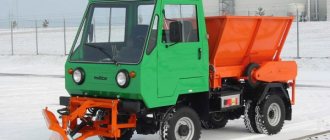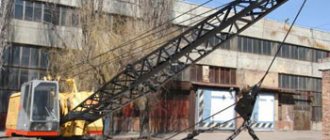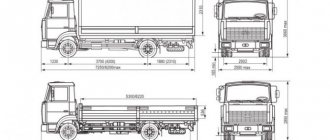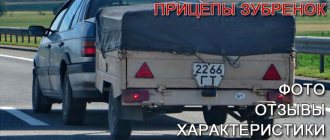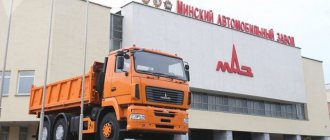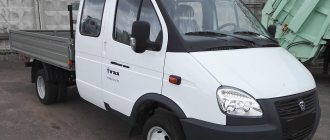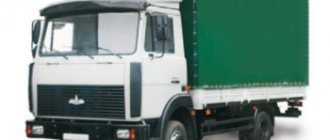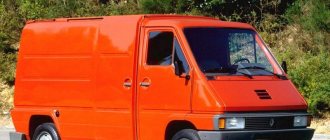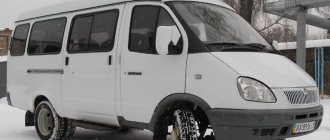The IFA-V50L flatbed truck transports 5.22 tons of cargo at a speed of 90 km/h. The car is equipped with a 125-horsepower diesel engine and consumes about 16 liters of fuel per 100 km. The Commissioner of the Automotive Industry Office of the German Democratic Republic, Dr. Gerhard Tietze, talks about the trucks that have been supplied to the Soviet Union since last year. Two new trucks with a cab over the engine appeared on the roads of many regions of the Soviet Union last year - a flatbed and a dump truck. These are IFA models V50L and V50L/K, built in the German Democratic Republic. Since these cars are little known to Soviet motorists, we want to tell the readers of the magazine at least in general terms about them. IFA trucks are produced by an automobile plant in Ludwigsfeld, not far from the capital of the republic, Berlin. He released his first products - five-ton trucks - in July 1965*. Today, the production program of the national enterprise is 22 thousand vehicles per year, representing about forty modifications of the basic V50L model. The plant is designed to satisfy the national economy of the GDR with a large number of vehicles for various purposes, widely unified among themselves. This greatly simplifies the organization of maintenance and the supply of spare parts. Some of the plant's products are exported to other countries. In addition to the basic model (V50L), Ludwigsfeld produces a modification with an extended chassis (V50L/Sp), with an isothermal body (V50L/IKB), refrigerated (V50L/IKST) and furniture (VbOL/M) vans, a truck with a hydraulic crane for self-loading ( V50LSH), dump trucks with one (V60L/K) and two (V50LA/K) driving axles, truck tractor (V50L/S), aerial platform (V50L/U), garbage truck (V50L/LK), as well as a sweeper (V50L/RK ), fecal (V50L/F), fire (V50L/DL, V50L/LF, V50LA/TLF) vehicles. All vehicles of the IFA-V50 family are equipped with four-cylinder (6560 cm3) diesel engines with direct fuel injection. At 2300 rpm, this diesel engine develops power of 125 hp. With. The maximum torque is 43 kgm at 1350 rpm. From the engine it is transmitted to a five-speed gearbox, in which second, third, fourth and fifth gears are synchronized. The box is not made in a block with the engine, but separately from it. This somewhat unusual design provides certain advantages during installation and dismantling. This principle is convenient for using a transfer case (on a version with all drive wheels), as well as for connecting various additional units and their drives. Among other features of the IFA-V50 gearbox, it is necessary to note the location of all shafts in a horizontal (rather than vertical) plane, the presence of four shaft supports (most often they are made of two or three) and a horizontal crankcase connector. The rear axle of the truck is also unique - the axle shafts are located not inside the axle beam, but outside. The presence of gearboxes at the wheel hubs made it possible to reduce the dimensions of the main gear reducer and thus provide increased (up to 300 mm) ground clearance. At the same time, the torque transmitted through the axle shafts decreased. Most of the modifications are basic. See "Behind the Wheel." 1966, No. 9. IFA-V50L/K dump truck with three-way unloading, unified with the V50L truck, designed for 4.4 tons of cargo and a speed of 76 km/h.30
In its homeland in the GDR, the IFA W50L did everything: a dump truck, a manipulator, a van for cargo transportation, but fire trucks were especially common - power and traction, coupled with driving characteristics, were ideal for such work.
Few modern drivers can clearly talk about the IFA W50 cabover van. However, drivers of the 70s and 80s remember this unassuming, boxy truck well. Moreover, you can still find advertisements on the Internet for the sale of a long-discontinued truck. Along with the car brand, the manufacturing country itself has sunk into oblivion.
IFA W50 car: historical excursion
15 years have passed since the last truck was released from the assembly line - a considerable period of time. The car itself was in good condition for a quarter of a century, starting from 1965 and 1990. During this time, 571,800 cars were released and were able to demonstrate their performance characteristics. Many of them worked on the territory of the Soviet Union. And its history began with the Second World War.
Or rather, since its end. The post-war period is a time of creation and restoration of the destroyed economy and industry. When, if not at this time, to engage in transport development? One of the striking examples of this approach is fellow countryman IFA 50w,.
The history of Ifa W50 began at the plant in Ludwigsfeld. In pre-war times, this plant was owned by the Daimler-Benz company, and at the end of the war, Germany was divided and the plant came under the control of the GDR authorities. The market needs at that time were simple: a convenient and simple five-ton truck with good cross-country ability was required. Development of a new vehicle began at a plant in the city of Werdau based on the already produced Sachsenring S4000 van, which transported about 4 tons.
One of the many versions of the IFA W50 - the cabin is double and can accommodate a whole team of workers
This is how the prototype W50 appeared. At that time (since 1960), the W45 was produced at the Ludwigsfeld plant. However, by that time the series had already ceased to be relevant. The W50 was supposed to be the successor to the W45 model, while from the S4000 it received a vortex chamber diesel engine with 4 cylinders and 110 hp.
Especially for the new truck, the power was increased from 90 hp. The car was tested in two versions: with rear-wheel drive and all-wheel drive. The model was assessed as promising and a decision was made on serial production. For production, a new plant had to be built, where new five-ton trucks were produced.
Years of production of IFA w50: formation of the model range
The correct spelling of the truck's name is W50. "W" is for Werdau, where the car was built and tested. The letter “L” added at the end indicates the origin - the manufacturer. Over time, the abbreviation IFA began to be added to the vehicle, since the vehicle was actively exported and the abbreviation for the Industrial Association of Automobile Manufacturers of the GDR (Industrieverband Fahrzeugbau) helped to navigate the origin of the truck.
The number in the name indicates the carrying capacity, but not in kilograms, but in centners. The new IFA immediately received widespread adoption and recognition. There were several reasons for this. Firstly, the cabin located above the engine looked unusual and curious.
However, during operation it turned out that it is not folding, which means repairs cause a lot of inconvenience. Secondly, due to such a cabin, the dimensions were reduced, while the length of the cargo platform was convenient for loading. Thirdly, at that time it was a fairly powerful five-ton truck. The first versions of the truck had the following technical parameters:
- Cabover design with a two-seater cabin;
- Diesel engine with water cooling;
- Engine torque is 422 Nm already at 1500 rpm;
- Dependent, leaf spring suspension;
- Ground clearance - 300 mm;
- Brake system: hydraulic, drum brakes;
- The turning radius is only 7.1 meters.
Some details of the truck can be seen in the video clip dedicated to one of the modifications:
And even though the car was not very economical (consumption up to 25 liters per 100 km/h), it turned out to be quite playful. The maximum speed developed by the IFA w50 was 83 km/h. The car quickly spread throughout the countries of the so-called “socialist camp”, and also reached other continents, Africa and exotic countries. In the USSR, he had to fight such proven trucks as the four-ton GAZ-53 and the five-ton ZIL-103.
Compactness, greater reliability, maneuverability and relatively low fuel consumption allowed the IFA to come out ahead. And the visibility of the W50L was better and of higher quality due to the cabin layout. The car entered the export market in two modifications: the main W50L (wheelbase 3200mm) - a flatbed truck. The W50L/K three-way loading dump truck turned out to be no less popular.
Also offered were trailers produced by the same IFA - HW60.11, for using the truck as a road train. All-wheel drive versions, isothermal vans, auto repair shops and chassis based on the 50 were less common in the Union, although they were also produced in the GDR. In the GDR itself, these vans gained the greatest popularity as fire service vehicles. According to the common German tradition, cars of this kind were converted into motorhomes.
IFA W50 car characteristics and modernization
The first changes were not long in coming and they affected, first of all, the internal systems of the truck. The engine was accelerated to 125 “horses” and the volume was increased. The direct fuel injection system and the engine itself were manufactured under license from MAN. In addition, the power unit received an engine brake.
When the gas pedal was released, a special damper opened, blocking the exhaust. Thus, braking occurred due to the diesel engine. Soviet drivers fully appreciated the opportunity to save on brake pads and took advantage of the operating time on slippery roads and in difficult, mountainous terrain. There was also an opportunity to save on fuel.
At low speeds, only two of the four cylinders were allowed to operate, which made it possible to reduce overall consumption. However, vibrations from engine operation in this mode were felt more strongly in the cabin. The transmission was a manual gearbox with synchromesh from second to fifth gear. Separately, it is worth mentioning the design of the rear axle.
Fans of dirt and off-road will certainly appreciate this modification of the IFA W50 - for many, having such a “horse” is a dream.
There was also a military version of the truck. What was its difference from the civilian one is difficult to say now. Perhaps this is the round design of the hatch (on regular vans it was square). We can definitely say that the air intake was located in the windshield area, and not under the cabin. Be that as it may, the IFA W50L was in service with the Iraqi army during the military operation in the Persian Gulf in 1991.
Due to the presence of final drives in the design, the designers managed to achieve 300 mm ground clearance. The torque supplied to the axle shaft was reduced, and the additional load was taken on by a tubular beam. Knowing the harsh Russian climate, it was optionally proposed to include a center differential lock in the package. Since the 70s, changes have also affected the suspension.
The spring, dependent suspension was supplemented with transverse stabilizers and telescopic shock absorption. Owners of all-wheel drive versions had the opportunity to install power steering. In 1973, updates affected the steering mechanism. The brake system at that time had a pneumatic outlet and a brake pedal booster.
Community of interests in Africa
The interest of East Germans in the Western auto industry is understandable; the Aussies were hopelessly behind the Wessies in the development of this area of industry and were not averse to acquiring their neighbors’ technologies along with investments. But what interest could Germany have in the state-owned automobile industry of the GDR? The West Germans did not need the supply of obsolete cars, nor did they need technology. However, in the 1970s, the interests of the automobile industries of both countries collided in export markets. Companies from Germany, successfully exporting their cars to all parts of the world, had just begun to develop the markets of developing countries in Africa, entering into competition with the French, British, Italians, Swedes, Japanese... Much depended on the political situation there.
States focused on building socialism traded with the countries of the Council for Mutual Economic Assistance (CMEA) and China; cars from Germany arrived there only in small quantities. But technology from the countries of the so-called “Eastern Bloc” gradually penetrated into states dependent on the West that were building capitalism, primarily due to reasonable prices. Trucks from the USSR and Czechoslovakia, buses from Hungary became serious competitors in the markets of Africa, Asia and Latin America; they optimally met the requirements similar to their own specifics. After the GDR was recognized by the world community, a new energetic actor appeared on the scene.
The African interests of the two German states intersected in Ghana. It was Ghana that Germany chose for economic expansion in West and Central Africa. The prerequisites for this were a more or less stable political situation, acceptable conditions for investors, the presence of sea ports and a relatively developed infrastructure. The market for cars for various purposes was growing in the country.
In 1974, the very first plant in the automotive industry, Neoplan Ghana Ltd, opened in the city of Kumasi, 55% of its shares belong to the Republic of Ghana, 45% to the Gottlob Auwärter company, the starting capital is 700 thousand German marks. Buses will be built there. And what kind! Known throughout Europe, regular winners of international competitions, chic and comfortable!
But for Ghana there are simpler options, specially designed for African conditions, simple and not very expensive cars on special chassis from European manufacturers, called Tropic Bus. Other well-known companies also offered buses there, but, as a rule, they were made on the chassis of ordinary trucks. The joint venture Neoplan Ghana successfully entered into competition with them.
In 1978, a second plant was opened in Accra, which took over maintenance and repair, with an annual capacity of up to 150 machines. The markets of Ghana and neighboring countries such as Upper Volta (Burkina Faso), Cameroon, Mali, Niger and Nigeria are massively supplied with high-quality aircraft of various capacities, built mainly on the chassis of the Dutch company DAF and equipped with air-cooled Deutz diesel engines, whose representation was taken over by himself and Neoplan Ghana. It should be noted that buses with a rear engine are atypical for those places.
However, despite the local production of bodies in Ghana, their cost is still high. The company is looking for a budget alternative, and begins producing classic African buses on the chassis of Volkswagen and MAN trucks, and later Mercedes-Benz. The line opened in 1970–1990 with small-capacity cars model N 305 on the Volkswagen LT 31 chassis, then in ascending order - N 308, N 309, N 310, N 312, N 313, N 314 and up to the luxurious two-story liner N 322. Then it was supplemented with improved types N 411, N 412, N 414... But we will focus on one rare model of a classic layout for that time, unusual even for Africa - N 311.
IFA w50 truck: end of production
The reliability and quality of the truck has never been disputed - relatively rare upgrades speak of this. In addition, there were dozens of models for various purposes that rolled off the assembly line regularly all these 25 years. Be that as it may, by the early 80s, IFA W50L began to inevitably lose relevance, giving way to new products that were multiplying like mushrooms after rain. By that time, the manufacturer had prepared the next generation of IFA.
The cabin and interior of the IFA W50 are simple, but at the same time comfortable: the seating position is high, and the visibility is better than many trucks of that time.
Soviet motorists no longer saw the new truck, but they had heard a lot about it. The IFA w50 has been replaced by the updated IFA 60L. The difference between these cars was striking. All minor shortcomings were taken into account: the cabin became tilting and now accommodated three passengers.
Operating power increased: the 9-liter engine developed 180 hp. and was paired with an updated 4-speed gearbox with synchronizer. The carrying capacity has also increased to 6 tons. And the car would live happily ever after... But the course of history that launched the IFA W50L and its descendant also inexorably ended their release. In 1990, Germany reunited, the GDR ceased to exist, and the plant began to belong to Daimler-Benz again. IFA W50 and 60L seemed unprofitable to German specialists and production was discontinued.
The IFA W50 medium-duty truck was produced from 1965 to 1990 at the Ludwigsfeld plant in the German Democratic Republic. Over a quarter of a century, more than half a million trucks rolled off the plant’s assembly line; the vehicles were massively exported to the countries of the socialist camp, as well as to the countries of Asia and Africa. Many modifications and add-ons were created based on the car. After the reunification of Germany, the production of the obsolete model was considered unprofitable, and in 1990 the production of the truck was finally discontinued.
Design
Built on a 3.2 m (10 ft) wheelbase, many different versions were developed over the years (around sixty different models were available directly, and other firms may have produced special versions). Two wheelbases were available: 3.2 and 3.7 m (10 and 12 ft). Right-hand drive models were built for export and for special uses such as street sweeping. The W 50 was also popular with firefighters, especially as the LF16 TS8 pumper, and many examples were still in service.[ when?
] in the former East Germany. [
citation needed
]
However, according to the original description, the engine was standardized: for the first two years it was an updated version of the unit used in the IFA S4000-1: 110 hp. (81 kW). The diesel vortex chamber was called “4 KVD 14.5 / 12”. In 1967, a direct injection version of this diesel four-cylinder replaced it. Like the earlier version, the "4VD 14.5/12-1 SRW" has a displacement of 6.56 L (400 cu in), but here it develops 125 hp. (92 kW) at 2300 rpm.[11] The engine was built by VEB IFA Motorenwerk Nordhausen in the town of the same name.[3] After 1973, it was replaced by the slightly modified “4VD 14.5 / 12-2”. The new version was a better cold starter and continued to operate in temperatures as low as -40 °C (-40 °F) to NVA requirements.[ citation needed
]
All W50 trucks were equipped with a single-plate dry clutch and a five-speed manual transmission with synchromesh in gears 2-5. All-wheel drive models have a transfer case with a locking differential.[12]
Hungarian bus manufacturer Ikarus also made a rear-engine mid-sized bus called the 211, which used various parts from the W 50, including the engine and axles.[13] It was built from 1976 to 1990, when the disappearance of the W 50 meant it had to be discontinued.
History of creation
Sea trials of the first prototypes of the truck began in 1962. As a basic version, a machine with a lifting capacity of 5 tons with a 90-horsepower 4-cylinder water-cooled engine was tested. At the same time, tests were carried out on the all-wheel drive version.
Initially, they wanted to establish mass production of the truck at the car plant in the city of Werdau, however, this required a large-scale reconstruction of the enterprise. As a result, it was decided to adapt the production site in Ludwigsfeld, near Berlin, for the production of the new truck. The plant's capacity allowed it to produce up to 15 thousand cars annually. The first W50 trucks rolled off the assembly line of the car plant in 1965.
The design of the car incorporated ideas that were advanced for its time, and traditional German quality and reliability contributed to the popularization of the model.
Tens of thousands of trucks were exported to the USSR. The niche of medium-duty trucks in the Soviet Union was occupied by the GAZ-53 and ZIL-130, and the German car beat their competition due to better quality, cabover layout and fuel efficiency. Of the numerous modifications, a flatbed truck and a dump truck with the possibility of three-way unloading were supplied to our country.
Deliveries of the truck to the USSR and other countries continued until 1987. Then they wanted a new W60 truck to replace the outdated model, but the political cataclysms that soon followed, which led to the liquidation of the German Democratic Republic, did not allow the implementation of existing plans.
Somersault Germany – GDR – Ghana
So, the W50 trucks appeared in Ghana and immediately attracted interest. Their prices were reasonable, often even more reasonable than for cars assembled in Africa from European parts. In addition, the GDR pursued a reasonable trade policy, willingly agreeing to barter. Trucks were even exchanged for bananas, due to the shortage of which thousands of East Germans risked their lives to flee across the border to the West. This did not cause concern to the management of the Neoplan Ghana branch, because the factories of the IFA association did not produce large-class buses. After some thought, the West Germans decided to use the situation to their advantage. In February 1984, the implementation of an unprecedented deal began - the West Germans agreed with the East Germans to jointly develop the “tropical bus” Neoplan-IFA (as it was called in the press) and supply 100 units of extended W50 chassis to Ghana to equip them with bodies locally.
At first they decided to produce ten experimental chassis with a wheelbase of 4600 mm in Ludwigsfeld, but they were not made there. The West Germans rejected the proposal to build 47-seater buses on the W50 L/Sp chassis with a wheelbase of 3700 mm. The plant workers had to lengthen these chassis in order to increase the number of seats to 55. The capitalists undertook to supply the bodies. In February 1984, comprehensive tests of the first experimental bus chassis with increased ground clearance began in the GDR; by June they were successfully completed. Soon, the Gottlob Auwärter plant in Pilsting equipped two chassis with Neoplan bodies and began testing the buses. One was tested in the GDR, the other was sent to Ghana. Meanwhile, the plant in Ludwigsfeld produced eight more long-wheelbase bus chassis - they were called W50 L/B-GH (the letter B stood for Bus, the letters GH for Ghana). Buses for Ghana first received the same name as cars of this class for the German market - Neoplan SK 1 (the letters SK meant “standard small bus” - Standardkleinbus). But soon the model index was changed to N 311 Tropic Bus in the City (55 seats + 25 standing) and Intercity (55 seats) modifications.
Some German chroniclers claim that this is where it all ended - the eight finished chassis did not turn into buses. They were equipped with cabins and light platforms for transporting foam and sent to Dresden. Indeed, in 2003 in Ludwigsfeld, on the territory of Thiele GmbH, one unknown photographer photographed such a chassis with a truck cab installed on it. However, judging by the surviving photographs, at least two buses were tested in the GDR alone, which differed from each other in appearance. There is also reliable information that serial production of Neoplan-IFA buses took place in Ghana. This is confirmed both by photographs and short reports in the specialized press of those years.
In 1986, Neoplan Ghana factories hastily produced 100 buses on the MAN chassis for the largest local passenger carrier and began assembling a new batch of the same vehicles. At the same time, the assembly of Neoplan N 311 Tropic buses began, including for export. It has not yet been possible to find exact data on the number of machines manufactured. It is known that Neoplan Ghana temporarily took over the representation of W50 trucks and was probably fine-tuning them to the requirements of the local market. But, apparently, joint work with the GDR did not last long.
In tight spaces, no offense to both the passengers and the driver of the Neoplan N 311
In March 1986, the first 19 experimental six-ton trucks of the new L60 family (this time the letter L in the brand meant the Ludwigsfeld design) with 180 hp engines were assembled in Ludwigsfeld. Their mass production began the following year. The plant's management had high hopes for the new machine, especially for its export. The plant's facilities were hastily prepared to replenish the model range; interest in building a small number of bus chassis of the old model disappeared. Another official reason for the termination of the contract between Germany and Ghana is considered to be customer dissatisfaction with some shortcomings in the design of the bus. Access to individual units of the 125-horsepower diesel engine was provided on the Neoplan N 311, but partial dismantling of the body was required to replace the entire engine. In addition, the hood turned out to be too heavy for “delicate” African drivers. But there were, of course, other reasons, and they came from our West German partners.
Part 1 Part 2
IFA W50 modifications
The family of trucks was represented by many modifications, differing from each other in wheel arrangement, dimensions, base dimensions, and cab concept. In addition to the most common flatbed trucks and dump trucks, the car was produced in versions of a long-wheelbase truck and an all-wheel drive tractor. Various superstructures were installed on the chassis - double-row cabins, mobile workshops, fire engines, insulated vans. In most cases, such modifications were produced in small quantities according to special orders.
The car was also produced in an all-wheel drive military version for the armed forces of the GDR. In terms of its technical characteristics, the military truck was not much different from the base model.
Engine and gearbox
The first batches of trucks were equipped with powerful forced diesel engines S 4000-1 with a capacity of 100 horsepower. A design feature of the W50 power unit was the presence of an engine brake system. When the accelerator pedal was released, the damper located between the muffler and the exhaust valve closed automatically, providing braking of the car. Engine braking was especially important when driving on icy roads and mountain serpentine roads.
In 1967, the car received a new 4 VD engine with 125 horsepower. In addition to increased power, the diesel unit, produced under license from MAN, received an improved direct fuel injection system. The new engine was distinguished by its efficiency. At idle and warm-up modes, only two cylinders of this engine were running, which contributed to increased fuel efficiency.
The disadvantage of the engines was their layout. The bulky engine compartment was located under the IFA W50 cab, but the truck’s design did not allow for tilting the cab forward. The engine compartment hatch was located between the driver and passenger seats, which created problems during maintenance and repair of the power unit.
The engine was coupled via a shaft to a 5-speed manual transmission with synchronizers in 2nd, 3rd, 4th, and 5th gears. Due to the autonomous location of the unit on the frame in the under-cabin space, it was easily dismantled during repairs.
Recommendations
- ^ a b c d f
Kirchberg 2000, paragraph 756. - ^ a b
Schauen, Till (December 2015).
"Bau-genossen" [The joys of cooperative construction]. Last & Kraft
(in German). Vol. 24 no. 1 (December/January 2016). Mainz, Germany: Vereinigte Fachverlage. paragraph 64. ISSN 1613-1606. - ^ a b c
Schauen, item 65 - ^ a b
Kirchberg 2000, p. 438. - Kirchberg 2000C. 438–439.
- ^ a b c d
Kirchberg 2000, paragraph 440. - ^ a b
Kirchberg 2000, p. 449. - Kirchberg 2000, para. 450.
- ^ a b c d f
Kirchberg 2000, paragraph 634. - ^ a b c
Kirchberg 2000, p. 637. - Schauen, p. 67
- ^ a b
Werner Oswald (ed.): Kraftfahrzeuge der DDR, 2. edition, Motorbuchverlag, Stuttgart 2000, ISBN 3-613-01913-2. item 238 - Kismartoni, Andras (11 April 2015). “Kultikussá érhet a téeszek lenézett Ikarusa” [The despised Ikarus of cooperatives acquires cult status]. Origo
(in Hungarian). New Wave Media Group Zrt. - Kirchberg 2000, para. 6.
- Kirchberg 2000, para. 448.
- Kirchberg 2000C. 447–448.
- Kirchberg 2000C. 448–449.
- Kirchberg 2000, para. 452.
- Kirchberg 2000, p. 635, 637.
- Kirchberg 2000, para. 761.
Suspension and braking system
The design of the rear axle of the leading pair was distinguished by an original solution. In order to increase ground clearance to 30 cm and reduce the load on the main pair, the torque drive was supplied through wheel gearboxes, and the main load fell on the beam. In this case, the main gear turned out to be paired.
As an option, a design with lockable cross-axle differentials was offered. All-wheel drive versions of the W50 were equipped with a transfer case with a reduction gear and a locking differential connecting the front and rear axles.
The dependent suspension of the axles was built on springs. After another modernization carried out in the mid-70s, the design received an anti-roll bar. The softness of the suspension was ensured by telescopic shock absorbers.
The truck's braking system was also innovative for its time. Autonomous hydraulic drives were used to activate the front and rear drum brakes. The brake pedal was equipped with a pneumatic booster that reduces force. A parking brake with a pneumatic drive was installed on the wheels of the rear axle. The brake system included a pneumatic outlet for communication with the trailer brakes.
An onboard vehicle with a carrying capacity of 5.2 tons could tow a trailer weighing up to 9 tons. The curb weight of the truck was 4.6 tons. The maximum speed is 80 kilometers per hour, diesel fuel consumption is 17 liters per 100 kilometers.
Price IFA W50
Despite the fact that quite a lot of trucks were exported to the USSR, most of them were taken out of service in the 90s. Note that soon after the unification of Germany, a large batch of military versions of the truck arrived in Russia from the disbanded units of the GDR army, however, these vehicles soon began to fail due to a total lack of spare parts.
Today, cars in working condition are extremely rare. However, they can still be purchased on the secondary market. These are mainly cars produced in the second half of the 80s. Depending on the technical condition and modification, their cost ranges from 100 to 300 thousand rubles.
The W50 truck has become a landmark vehicle for the countries of the socialist community. In terms of its technical characteristics, build quality, reliability and fuel efficiency, it was in many ways superior to its analogues. The car is already consigned to history, and soon it will be considered one of the rare models. But even today, everyone who has had the opportunity to operate a truck remembers this reliable and unpretentious car with a kind word.
Training program
Receiving an IFA diploma confirms that the student has professional knowledge in the field of financial analysis. The curriculum includes an impressive list of disciplines, which include:
- IFRS, or international financial reporting standards;
- basics of auditing – internal and external;
- several types of management: strategic, financial, etc.;
- ethics of financial market participants and much more.
Having an IFA diploma significantly expands employment opportunities, both in Russia and abroad. The owner of the document is officially registered with the IFA with the possibility of obtaining associate member status in the future.
Video
Sometimes the past comes back to us. On the roads, especially far from big cities, you can find the German-made IFA Multicar. The GDR is a country producing a small, compact truck with a diesel engine. It is no coincidence that the IFA Multicar interests us. We want to find out the capabilities of the “long-liver”, technical characteristics. Find out the basic requirements for a trailer. Read the reviews of the owners and find out the possibility of purchasing it at the moment.
General information
The German car IFA Multicar photo, which is in the article, has already rolled off the assembly line of the IFA Multicar company. At the peak of its fame, about 10,000 trucks came out of the factory assembly line per month. Almost 100,000 units. Before the start of the Olympic Games, held in the USSR, 20,000 units of German equipment were imported, which to this day work and are found on our roads despite the retirement age.
At that time, the IFA Multicar 25 was equipped with a compact two-seat cabin with an excellent control panel. Compact and maneuverable, it could squeeze into any alley or street in a city or town. The turning radius was only 5 (five) meters.
German truck IFA Multicar characteristics,
which we are about to consider, was designed on a station wagon platform, where it was possible to install various types of equipment. The versatility of the model is evidenced by 20 (twenty) variants of its execution. The IFA Multicar truck, the cost of which is posted on the Internet, was produced as a van or a bulldozer.
A crane was often installed on it. Used as a dump truck. IFA Multicar price photo, which is available in sufficient quantities on the Internet, was equipped with a 2.0 liter diesel power unit with 45 selected German horses. Now about this in more detail.
IFA Multicar 25, truck modifications
The equipment in question was produced in only two modifications:
- Truck model M 2501.
- Compact small truck M 25L 02.
It should be noted that there was practically no difference. The design, wheelbase and powertrain are like twin brothers. The only thing that distinguished them was the loading platform. For the IFA Multicar model M 2501, thick sheet steel was chosen as a platform. This made repair work easier. It was dismantled very quickly. The IFA Multicar had one feature: a simplified procedure for loading and unloading various cargoes. This was possible thanks to the simple and quick opening of the rear and side doors. At the same time, the design of the fastening of the sides was simple, reliable and well thought out.
Unlike the M 2501 model, the M 25L 02 model has a higher side. This is their fundamental difference.
We deliberately do not focus on the exterior and interior of the truck, believing that this part of the equipment is not of interest today. For those interested in the “interior” of a cabin designed for two passengers, we recommend searching for videos on the Internet.
Benefits of an IFA Diploma
Obtaining a second diploma provides its owner with several significant advantages. The main one is a higher probability of finding a prestigious and well-paid job. Other significant advantages include:
- increasing the competitiveness of specialists in the professional labor market;
- confirmation of international qualifications;
- preparation and provision of financial statements prepared in accordance with IFRS, with the right to sign;
- expansion of possible areas of professional activity, including auditing, comprehensive financial analysis and other similar work;
- no need to confirm a Russian diploma when applying for a job abroad;
- prospects for becoming an associate member of the IFA when passing the next stages of training.
Do not forget that confirmation of qualifications according to the international standard clearly shows the high level of training of a university graduate. Moreover, this applies equally to both diplomas – the main one and the IFA. Only a few Russian universities have the right to issue such documents. Therefore, it makes sense to dwell in more detail on the advantages of studying at the Institute of International Economic Relations.
Technical characteristics of IFA Multicar 25
The IFA Multicar characteristics we are considering were equipped with a small four-cylinder diesel power unit with a capacity of 45 l/hp. This was quite enough for the baby, because his weight was 1750 kg. Naturally, the use of diesel fuel as fuel made it economical.
Close ties between the two states and an established system for the supply of spare parts ensured their stable price. Made the renovation work a smooth process. Multicarmodel range ,
which we are considering, consumed only 8 liters of fuel per 100 km on a combined cycle. Speed capabilities were limited to 50 km/h on the speedometer.
Dimensions:
- length – 4240 mm;
- width – 1850 mm;
- height – 2000 mm.
Judging by the data, the truck could easily fit in any garage. Dimensional data gives reason to talk about its compactness and maneuverability. Especially when it comes to moving within the city.
It is prohibited to start the engine at high speeds when the air temperature is below 0 0 C. Gradual warming up of the power unit is necessary. Failure to comply with this condition may result in damage or failure of the bearings.
The IFA Multicar characteristics we are talking about were very durable and easily tolerated increased loads. It was as if the German comrades had created it for our roads. The “hodovka” was simply unkillable. IFA Multicar model photo, which is posted on the World Wide Web, is equipped with a trailer with a ground clearance of 26 cm.
This distance from the ground made it easy to move along country and dirt roads, to overcome holes and potholes. The IFA Multicar photo model, which is available on the Internet, was fitted with standard 13-inch wheels. If it was necessary to increase ground clearance, wheels of larger diameter were used.
The IFA Multicar trailer model M 2501 in question could take on board up to 1200 kg of various cargo. The trailer was especially valued among the rural population, on collective farms, farms and small industries.
IFA Multicar owner reviews
The owners' opinions are clear. It is not a ghost wandering our roads. A legendary truck made in Germany from the last century still moves along them. There are many advertisements on the Internet for the sale of this equipment. If there is supply, then there is demand. When selling IFA Multicar, photos are posted without fail. You can see in what condition, at least externally, the proposed truck is. There is an official dealer in the Russian Federation that supplies and sells this equipment. Now the IFA Multicar model range will be represented by M27 and M31 variants. This means that we will continue to see this equipment on our highways and in cities for a long time.
